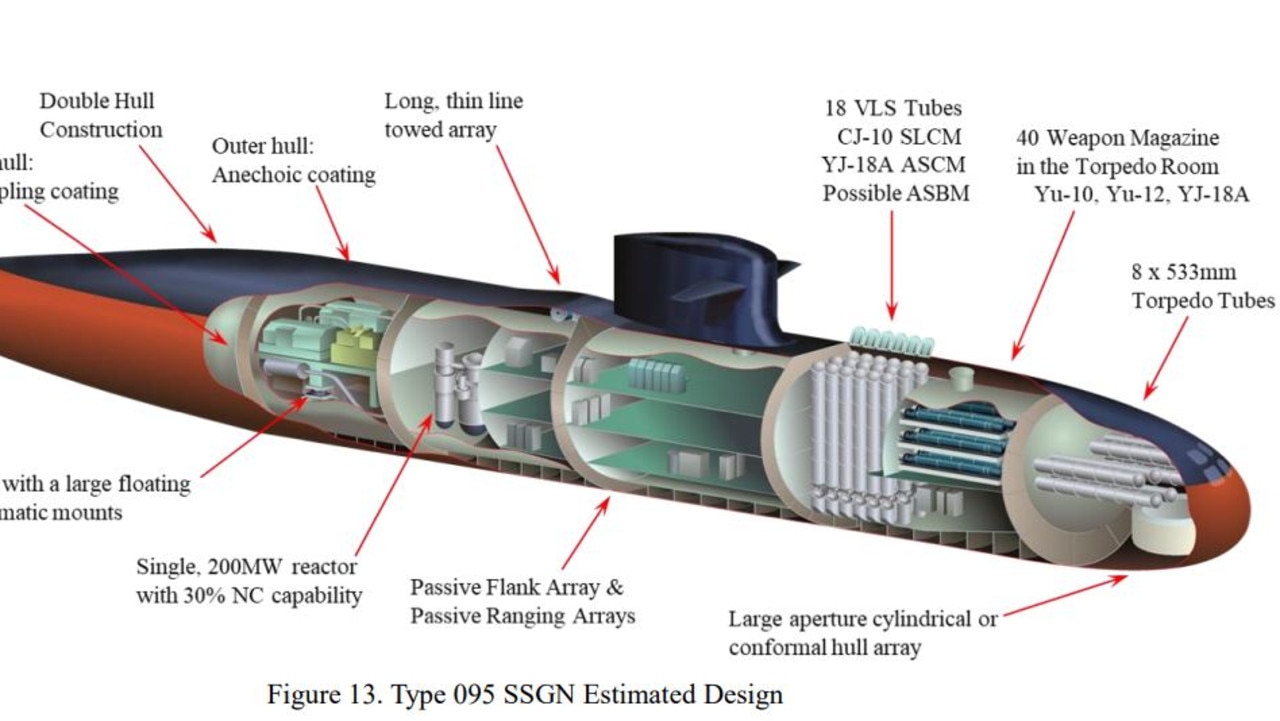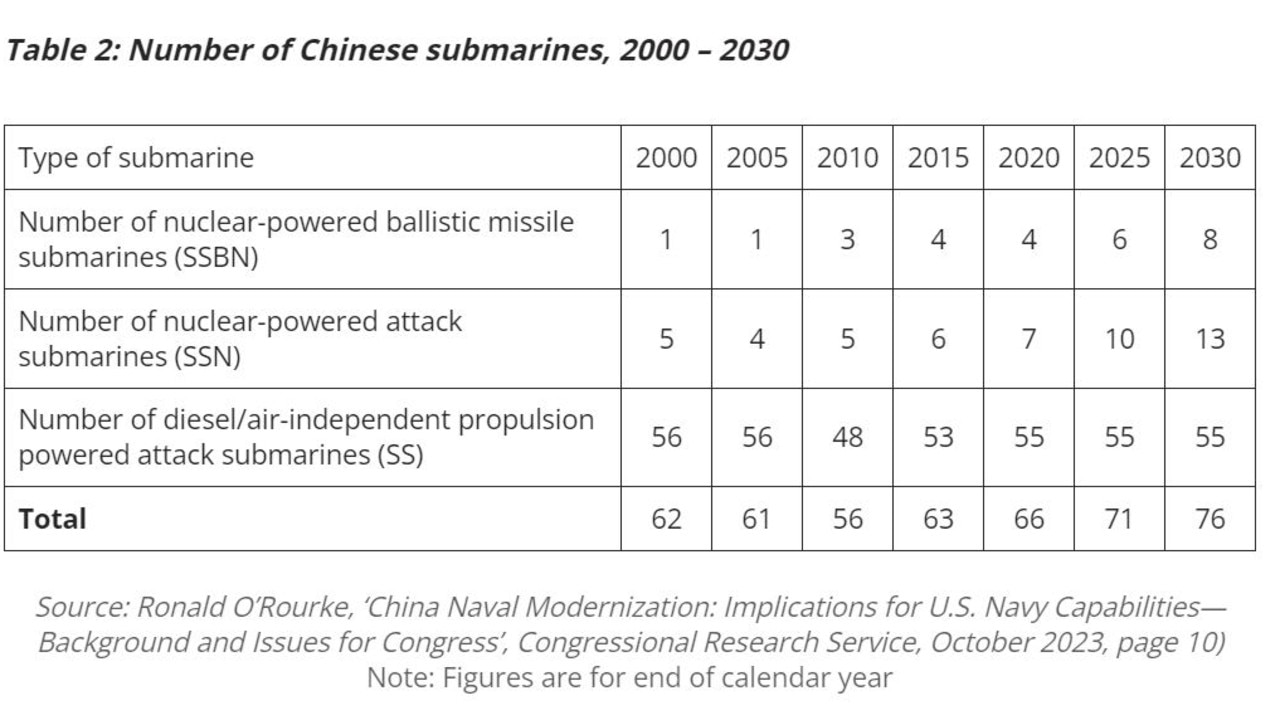New photos show China is dramatically expanding its submarine fleet
New satellite photos have exposed how hard China’s pushing to dramatically expand its fleet of deadly submarines.

Silent. Unseen. Lethal. The power of modern nuclear-powered attack submarines is why Beijing doesn’t want Australia to get them. But new satellite photos expose how hard China’s pushing to dramatically expand its own fleet.
Its recently enlarged assembly halls and dry docks at Huludao, Liaoning province, are a hotbed of activity.
And analysts say this is evidence Beijing’s plans to mass-produce new generations of nuclear-powered (and armed) attack and ballistic missile submarines are advancing rapidly.
“It looks like they’ve been busy indeed,” says Centre for a New American Security (CNAS) analyst and former submariner Tom Shugart.
Imagery update: just acquired some imagery of the PRC's Huludao nuclear submarine shipyard, and it looks like they've been busy indeed.
— Tom Shugart (@tshugart3) July 8, 2024
First up, there's what appears to be another Type 093B SSGN on the shiplift coming out of the new submarine construction halls to the east. pic.twitter.com/TsNVr8w93f
His analysis of recent satellite photos shows a new Shang III (Type 093B) nuclear-powered missile-attack submarine (SSGN) on a ship lift after being delivered from the construction halls to a dry dock.
He’s also identified what he suggests may be a section of a new type of submarine being transferred into the halls for assembly.

Also, in front of one of those halls is what might be a new submarine stern section.
— Tom Shugart (@tshugart3) July 8, 2024
Best I can tell, the hull section at its widest point is about 12m. If accurate, could be part of one of the new Type 095/096 class boats rumored to be on the way. pic.twitter.com/ZV8TwEOryD
“Best I can tell, the hull section at its widest point is about 12m,” Shugart writes. “If accurate, could be part of one of the new Type 095/096 class boats rumoured to be on the way.”
Meanwhile, the Huludao construction facility currently hosts a large proportion of China’s nuclear-powered submarine fleet.
Nearby, there's also a Type 094 Jin SSBN.
— Tom Shugart (@tshugart3) July 8, 2024
Again, unclear if it's an older boat back for maintenance, or... pic.twitter.com/W0X5tKrt51
Three other Type 093 attack boats are docked at the yard. As is a Type 094 “Jin” ballistic missile-carrying submarine (SSBN).
“Last year’s DoD (Department of Defence) China Military Power Report surprised me by stating that Type 094 construction had been resumed,” Shugart tweeted. “Could be a new boat?”
The US Department of Defence’s China Military Power report released in October last year restates the PLAN was operating six strategic nuclear submarines (SSBN), six nuclear attack submarines (SSN/SSGN), and 48 conventionally powered submarines (SS).
However, the transfer of advanced Russian stealth technology to China means that the next generation of vessels will pose a much more severe threat to aircraft carriers, transports and distant infrastructure.

Silent service, tough talk
In May, Foreign Ministry spokesman Wang Wenbin reaffirmed China’s plans to use the International Atomic Energy Agency (IAEA) and Nuclear Non-Proliferation Treaty (NPT) bodies to challenge the AUKUS nuclear submarine deal.
“AUKUS nuclear submarine co-operation harms efforts to keep the region peaceful and secure,” Wang said. “(The US, UK and Australian) moves exacerbate the arms race, undermine the international nuclear non-proliferation regime, incite bloc confrontation and hurt regional peace and stability.”
But China’s massive naval construction program and dramatic nuclear force expansion have unsettled the world.
A Type 074 LST was used in a SINKEX, getting torpedoed by a PLAN submarine. Via 沉默的山羊/Wb pic.twitter.com/BEtpsAljYn
— Alex Luck (@AlexLuck9) June 16, 2024
The Pentagon says the Chinese navy now has “the ability to conduct long-range precision strikes against land targets from its submarine and surface combatants using land-attack cruise missiles, notably enhancing (China’s) power projection capability.”
It’s a capability French, British and US submarines have demonstrated in strikes against Iraq, Syria and Afghanistan in recent decades.
The Pentagon adds that it expects the PLAN to have three Shang III (Type 093B) nuclear-powered cruise-missile-carrying submarines in operation by the end of this year, with a new and improved class poised to replace it.

Meanwhile, Beijing continues to accuse the AUKUS project of nuclear proliferation.
“The three countries’ co-operation involves the transfer of nuclear power reactors and a large amount of weapons-grade HEU (highly enriched uranium),” states Wang. “If the three countries insist on going through with the nuclear submarine co-operation, it will trigger enormous risks of nuclear proliferation and have a far-reaching negative impact on the resolution of other regional nuclear hotspot issues.”
Canberra, however, says it has found a way to sidestep such fears.

It says the nuclear reactors carried by the AUKUS submarines are sealed, and the fuel cannot be removed. And once a submarine is decommissioned, its reactor - and spent fuel - will be returned to the nation that built it.
Power projection
China launched its first nuclear-powered submarine in 1974. But the skeletal force initiated a rapid update and expansion program shortly after Chairman Xi Jinping came to power in 2013.
Earlier this year, Chairman Xi promoted a submariner - Admiral Hu Zhongming - as the new chief of the navy.
“An overriding consideration behind putting a submariner in charge may have been to ensure that the PLA Navy’s long-troubled nuclear submarine expansion program advances safely and effectively,” states military analyst Andrew Erickson.
And the Pentagon says China is pressing ahead with steady production, regardless of a design’s success.
“It is unclear whether continued JIN-class SSBN production is the result of delays in the development of the PRC’s next-generation Type 096 SSBN or is an effort to accelerate its sea-based nuclear capability as Xi has directed”, the Pentagon’s China Military Power report reads.
A recent US Naval War College report has assembled what open-source material it can find about the new Type 095 design.
It points to clues indicating the boat will be one-third larger than the existing Type 093B. The extra space will allow it to accommodate new Russian noise-dampening technologies.
“The bottom line is that the Huludao shipyard is working up to produce submarine hull sections with large pressure hull diameters,” the report states
It also says satellite photos showing large new hull sections suggest the new submarines are not far off.
More Coverage
“After nearly 50 years since the first Type 091 SSN was commissioned, China is finally on the verge of producing world-class nuclear-powered submarines,” the War College report concludes.
“The Type 095 has the potential to approach the propulsion, quieting, sensors, and weapons capabilities of Russia’s Improved Akula class SSN. The Type 096 will also see significant improvements over its predecessors... Should China successfully make the jump in capabilities … the implications for the US and its Indo-Pacific allies would be profound.”
Jamie Seidel is a freelance writer | @JamieSeidel






